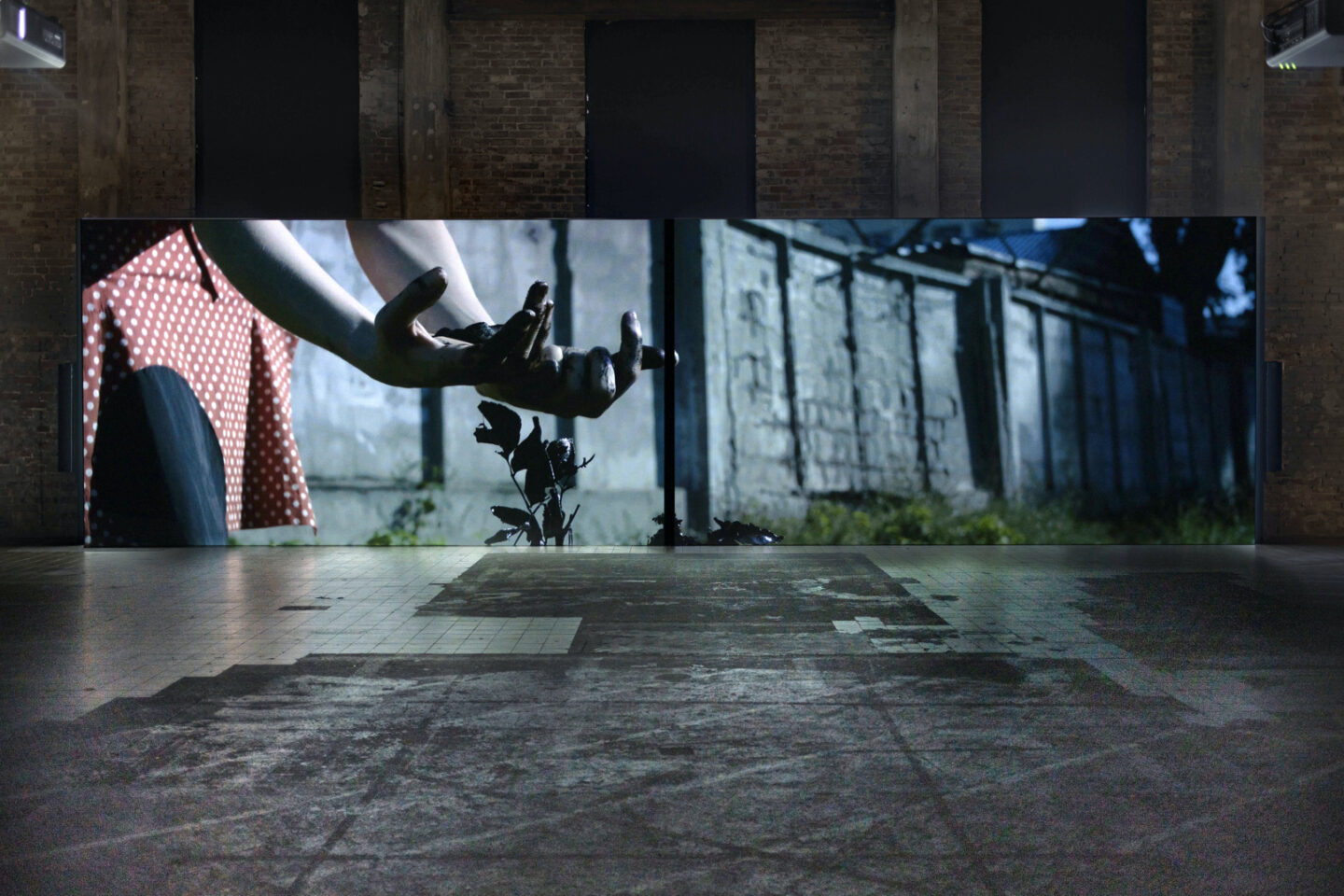Made possible with the support of Sharjah Biennial 2017, Sharjah, and Het Nieuwe Instituut, Rotterdam.
Written and directed: Metahaven
Cast: Ghina Abboud, Lera Luchenko
Director of photography: Yarema Malashchuk & Roman Himey, Karim Ghorayeb
Music: Mhamad A. Safa
Clothing: Yulia Yefimtchuk
Line production: Tania Monakhova, Jinane Chaaya
Ukrainian translation: Oleksandr Vynogradov
Russian translation: Alex Anikina
Arabic translation: Mohammed Abdallah
“Hometown” is a story of a non-existent fused city that emerges in front of the viewer through the entanglement of Kyiv and Beirut. Even though the film footage from both places is here inseparably intertwined creating a unity of landscape, the protagonists – Ghina and Lera – never meet. In the tale they tell by turns, a world of paradoxes and multiple meanings comes to life. Nothing is certain nor possible to predict here, yet stays familiar from beginning to end.
Through its visuals and languages the whole spectrum of imagination cracks open. We perceive the images as evidence of what is hidden and not expressed directly, just as in poetry, where a word or phrase generates many meanings and ideas that are not explicitly present. The physical space is perceived through the lens of the interface, as Lera tries to scroll and zoom on printed family photographs. In attempted close-ups of objects and people, we start to perceive the most common in an estranged way. Simultaneously, the network is shown through the rules of tangible objects, as it manifests itself through wires and talk of “ancient soil and data center heat.”
The rhythm, framing and editing of the film seem to stem from the gestures the characters make with their hands in the sky, evoking the manipulation of an image on a touchscreen. The screen, however, does not exist. The movements affect the image of the city, as if in this way they wanted to change the matter of places, transform their presence, get inside of the invisible and the non-existent. At times it is a smooth, slow movement, diving into a Beirut neighborhood. At other times it is a sudden, hasty movement, resembling CCTV footage that has lost its object and is nervously trying to track it down at Kyiv’s Independence Square. At the same time, reality does not change under the influence of these gestures, nor does it adapt to them. It remains independent and unchangeable. It cannot be virtualized and transformed into modifiable pixels. The viewer, therefore, tries to gaze with their eyes into the depths of the texture, zooming and cropping it for themselves.
The recipient is met with tangled cables, deserted living spaces, rooftop perspectives, infrastructure, razor wires, industrial sheds, walls, greenery, buildings’ façades seen against the backdrop of the sky. The intertwined and fused cities are shown in a strangely inverted geometry of broken mirror reflections, in which they are cut across with a thin line separating screen from screen. This inverted geometry coexists in the film with the words spoken by Ghina and Lera. Their oxymoronic statements superimposed on the images of the two cities’ mixed-up images do not, however, create the impression of contradiction. They give the images a sense of completeness, abolished dualisms, fluidity and connection, which – paradoxically – heals the wounds in the space of the cities.
Some phrases in the video are repeated, as if underlined, in various languages. Others differ largely between original and translations, conveying once poetic, once much more straightforward messages. This poses a question about whether the power of expression and the usage of words creates the definitions, and through that filters our understanding of things.
“Hometown” was filmed in 2017 and completed in 2018. So far the work was disclosed to the viewer in English, Ukrainian, Russian, and Arabic, and was translated into Polish especially for the second edition of Biennale Warszawa. It gains a new layer of importance today. Nowadays, both Ukraine and Lebanon struggle with extremely worsening forms of hardship, fighting their way for survival and experiencing massive human displacement. These are not without repercussions in Poland, exposing local systemic racism as well as wholehearted humanitarian aid simultaneously. The focus of the video stays turned to what is there, as a source of the human ability to continue to create and keep on dreaming.
The work of the Amsterdam-based artist collective Metahaven consists of filmmaking, textile art, writing, and design. Films by Metahaven include Chaos Theory (2021), Hometown (2018), and Information Skies (2016), nominated for the European Film Awards 2017.
Metahaven has participated in group exhibitions at: Artists Space, New York; the Museum of Modern Art, Warsaw; the Gwangju Biennale, Gwangju; the Busan Biennale, Busan; the Sharjah Biennial, Sharjah; and M HKA, Antwerp, among others. Metahaven, has created solo exhibitions at: MoMA PS1, New York; Yerba Buena Center for the Arts, San Francisco;, Izolyatsia, Kyiv; ICA, London; e-flux, New York; and State of Concept Athens, among others. Their work is in collections of the Sharjah Art Foundation, the National Gallery of Victoria, Stedelijk Museum in Amsterdam, and M HKA, among others.
Recent public lectures include: “An Evening with Metahaven,” The Museum of Modern Art, New York (2019); “After The Sprawl,” Castello di Rivoli, Turin (2019); “Inhabitant,” Harvard GSD, Cambridge (2020); and “Kaleidoscope?” with Flavia Dzodan (2021). Recent books include Digital Tarkovsky (2018).
